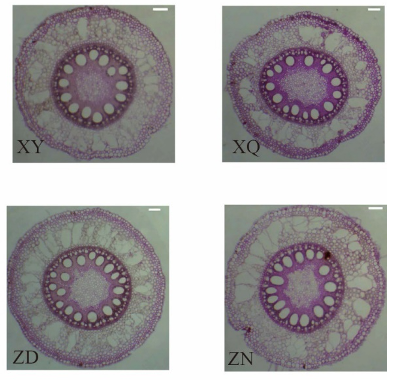
N acquisition efficiency of six hybrid maize lines
Authors
Guang-Jun Wu, Xucun Jia, Christopher Strock, Shu-Ting Dong, Ji-Wang Zhang, Bin Zhao, Jonathan P. Lynch, Peng Liu
Source
Plant and Soil 2022 10.1007/s11104-022-05331-6
Download Options
Plant and Soil
Abstract
Aims: To realize the so-called “Second Green Revolution”, it is imperative to study the roots of crop plants, and identify those traits that improve the efficiency of nitrogen (N) acquisition. We aimed to evaluate how the N acquisition efficiency of six hybrid maize lines commonly grown in northern China depends on their root anatomy.
Methods: Maize hybrids classified as having high nitrogen uptake efficiency (HNUE) and low nitrogen uptake efficiency (LNUE) were grown under high-N and low-N conditions in the greenhouse and the field.
Results: Under N stress in the field and the greenhouse, HNUE increased shoot dry weight, root length density, N content and nitrogen use efficiency compared to LNUE. Low N availability increased the percentage of root cortical aerenchyma and the size of cortical cells. Root anatomy, with greater formation of root cortical aerenchyma and larger cortical cell size, was associated with increased specific nitrogen absorption efficiency (SNAE) and shoot biomass under N stress. Under low N availability, the percentage of aerenchyma and their total area had significant positive correlations with the shoot dry weight, total N uptake, SNAE.
Conclusions: The results suggest that plants in limited N availability form more root cortical aerenchyma and have larger cortical cells, which is of benefit to root growth, soil exploration, N acquisition, and shoot biomass. These observations support the hypothesis that root anatomical phenotypes that affect the metabolic and construction costs of producing root length merit consideration as selection criteria for breeding to improve N acquisition in hybrid maize.
Authors
Guang-Jun Wu, Xucun Jia, Christopher Strock, Shu-Ting Dong, Ji-Wang Zhang, Bin Zhao, Jonathan P. Lynch, Peng Liu
Source
Plant and Soil 2022 10.1007/s11104-022-05331-6
Download Options
Plant and Soil
Abstract
Aims: To realize the so-called “Second Green Revolution”, it is imperative to study the roots of crop plants, and identify those traits that improve the efficiency of nitrogen (N) acquisition. We aimed to evaluate how the N acquisition efficiency of six hybrid maize lines commonly grown in northern China depends on their root anatomy.
Methods: Maize hybrids classified as having high nitrogen uptake efficiency (HNUE) and low nitrogen uptake efficiency (LNUE) were grown under high-N and low-N conditions in the greenhouse and the field.
Results: Under N stress in the field and the greenhouse, HNUE increased shoot dry weight, root length density, N content and nitrogen use efficiency compared to LNUE. Low N availability increased the percentage of root cortical aerenchyma and the size of cortical cells. Root anatomy, with greater formation of root cortical aerenchyma and larger cortical cell size, was associated with increased specific nitrogen absorption efficiency (SNAE) and shoot biomass under N stress. Under low N availability, the percentage of aerenchyma and their total area had significant positive correlations with the shoot dry weight, total N uptake, SNAE.
Conclusions: The results suggest that plants in limited N availability form more root cortical aerenchyma and have larger cortical cells, which is of benefit to root growth, soil exploration, N acquisition, and shoot biomass. These observations support the hypothesis that root anatomical phenotypes that affect the metabolic and construction costs of producing root length merit consideration as selection criteria for breeding to improve N acquisition in hybrid maize.

